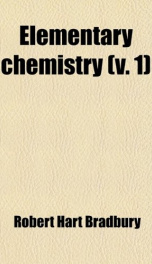elementary chemistry

Purchase of this book includes free trial access to www.million-books.com where you can read more than a million books for free. This is an OCR edition with typos. Excerpt from book: CHAPTER III Physical And Chemical Change The Law Of The Indestructibility Of Matter 28. Changes in matter.The material bodies which surround us are subject to continual change. Water left in free air disappears and enters the atmosphere as an invisible vapor, from which it appears again as solidsnow or hail, or as liquidrain, mist, or cloud, according to the conditions. When cooled it solidifies as ice and acquires quite different properties. Iron left exposed to air and water passes, first at the surface, and at last completely, into a soft, yellowish-red substance quite different from the iron, which we know under the name of rust. Bright surfaces of metals tarnish with a speed which depends upon the nature of the metal and of the air with which it is in contact. Even the rocks, so often referred to as examples of permanence, crumble under the influence of the weather into earth or clay, which is finally carried down into the sea and made into rock again. More rapid changes, like those which take place in a coal fire, or in a burning candle, are familiar. Finally, the very complicated changes which take place in the living body must be mentioned. 29. Physical and chemical change.It is convenient to divide changes of the kind referred to into two classes, the nature of which will be clear from a few examples. Physical Changes 30. Sulphur.A roll of sulphur is brought near to a small ball of pith or cork which hangs by a thread. There isno result. Now let the roll be rubbed with a cloth, and again brought near the ball. This time the ball is attracted and swings far out of the natural position. By friction the sulphur received an electric charge and this conferred upon it new properties, but it is still sulphur. In a little while the charge is lost and the new ...
Users who have this book
Users who want this book
What readers are saying
What do you think? Write your own comment on this book!
write a commentif you like elementary chemistry try:
Other books by this author
Do you want to read a book that interests you? It’s EASY!
Create an account and send a request for reading to other users on the Webpage of the book!


